Choosing the right size for your snorkel fins is akin to finding the perfect pair of shoes. Just as you wouldn’t want to run a marathon in shoes that are too tight or too loose, you wouldn’t want to snorkel with fins that aren’t a perfect fit.
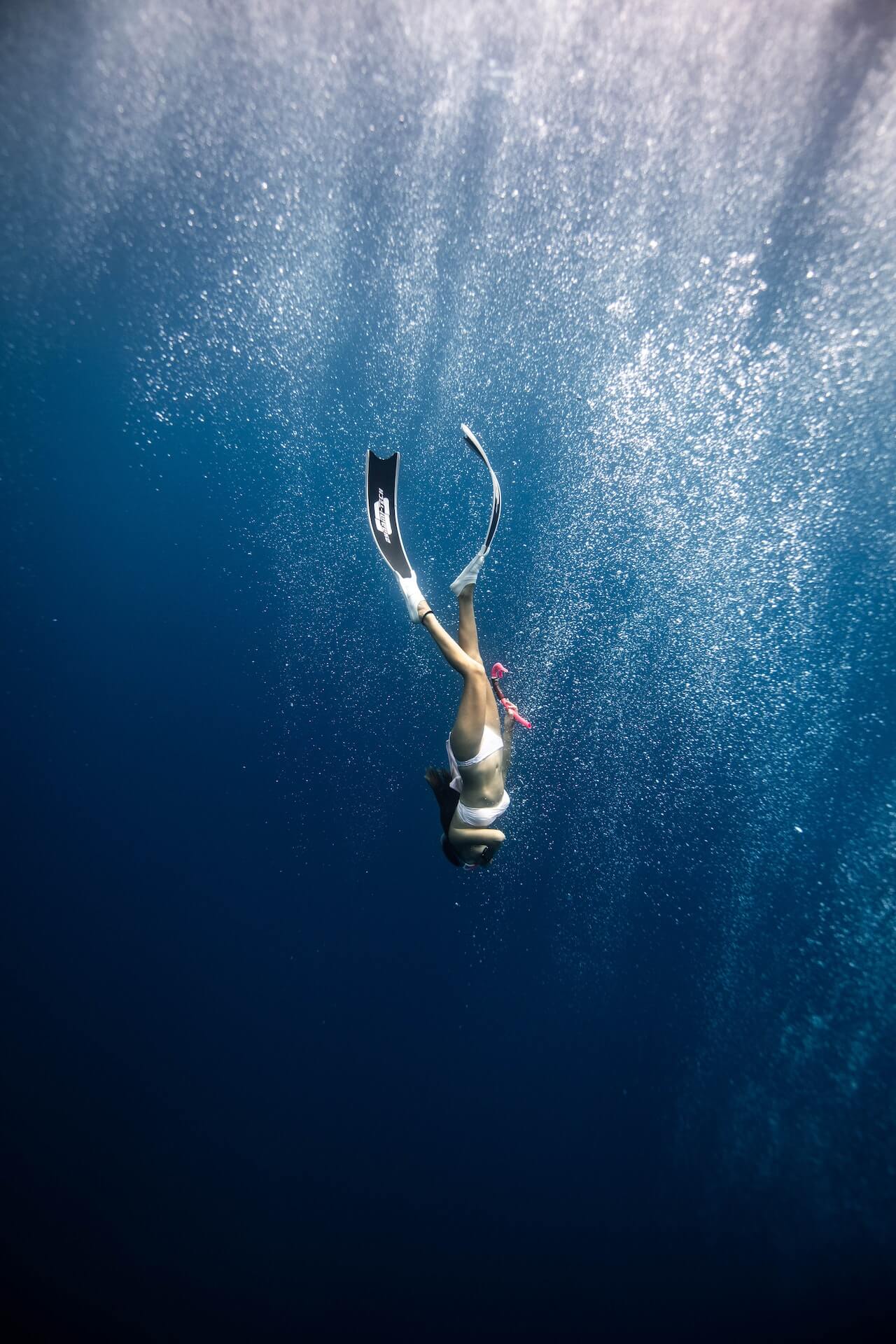
An ill-fitting fin can be more than just uncomfortable; it can affect your propulsion in the water, cause physical discomfort, or even lead to injuries. That is why in this article, we will go over the main considerations when determining the right size for your fins.
Choosing the Right Snorkel Fin Size (Step-By-Step)
This article is very information dense, so here is the concise version:
- Know Your Foot Size:
- Measure the length and width of both your feet. If possible, do it in the afternoon (feet can swell slightly throughout the day). Compare your measurements to the fins’ sizing chart.
- Consider if you’ll wear snorkeling socks or booties. If yes, account for that extra volume.
- A good starting point for men is to start out with a fin size the same size as their shoes. Women should start a size smaller than their shoe size.
- Consider Where You’ll Snorkel:
- Calm/Shallow Waters: Go for smaller fins that offer better maneuverability.
- Rough/Deep Waters: Choose larger fins with longer blades for more power.
- Consider the Water Temperature:
- Warm Water: Feet might swell, so ensure there’s some wiggle room in your fins.
- Cold Water: Feet may contract, so the fins should be snug, especially if not wearing insulated booties.
- Pick a Fin Style:
- Full Foot: Fits like a shoe; ideal for warm waters. Make sure it’s snug, especially if you won’t wear socks/booties.
- Open Heel: Comes with an adjustable strap; often used with booties for colder waters. Check the fit with the booties on.
- Consider the Blade Length:
- The length of the blade should be proportional to your body size and strength
- A longer blade provides more power and is suitable for experienced swimmers, while a shorter blade is easier to maneuver and is ideal for beginners.
- Consider the Blade Stiffness:
- The stiffness of the blade determines the amount of resistance you will encounter while kicking.
- A stiffer blade provides more resistance and is suitable for stronger swimmers, while a softer blade is easier to kick and is ideal for beginners.
- Try Before Buying (if possible):
- Some stores have mini pools or tanks to simulate the water experience.
- Ensure they’re comfortable and don’t rub in the wrong places when wet.
Again, this was the concise version of how to determine the right snorkel fin size for you. If you want the full version, keep reading on.
Determining the Right Size for You
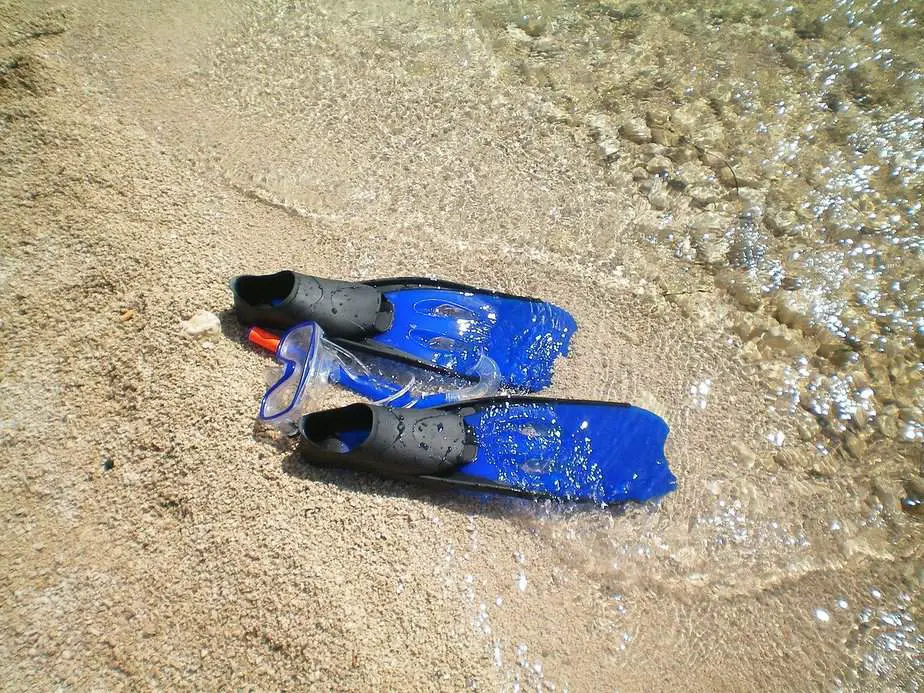
Measurement Essentials
Before you even start shopping, it’s essential to know your foot’s size and shape. Here’s what you need to consider:
- Foot Length: This is the most obvious measurement, and it’s usually the starting point. Use a ruler or foot measuring device, and measure your foot from the heel to the tip of your longest toe. Always measure both feet, as they can slightly differ in size.
- Foot Width: Just as vital as length, width ensures the foot pocket won’t squeeze your feet uncomfortably. Feet can be narrow, regular, or wide. If you’ve ever felt that shoes are too tight around the ball of your foot, you might need fins designed for wider feet.
- Arch Type: Your foot’s arch can influence how it fits inside the fin. There are primarily three arch types: low, neutral, and high. An easy way to determine your arch type is the “wet test.” Wet your foot, step on a piece of cardboard, and observe the imprint. If you see most of your foot, you likely have a low arch. If you see a significant curve from the ball to the heel, you probably have a high arch. The imprint’s shape can help determine which fins will provide the most comfort and support.
With these measurements on hand, it will be much easier for you to determine approximately how a pair of fins will fit by referencing its sizing guide.
Trying Before Buying
Just as you would with shoes, it’s often a good idea to try on fins before committing.
- In-Store Testing: If possible, visit a physical store. Here, you can slip on various fins and get a feel for their fit. Some stores even have mini pools or tanks to simulate the water experience.
- Consider Water Temperature: An often overlooked factor is the water’s temperature where you’ll be snorkeling. In colder waters, you might be wearing neoprene socks or booties, which can affect the fin’s fit. If you plan to snorkel in diverse conditions, bring your socks or booties when trying on fins.
- Check for Pressure Points: While trying on the fins, pay attention to any spots where you feel excessive pressure or rubbing, as these can lead to discomfort or blisters in the water.
Different Fin Styles and Their Sizing Nuances
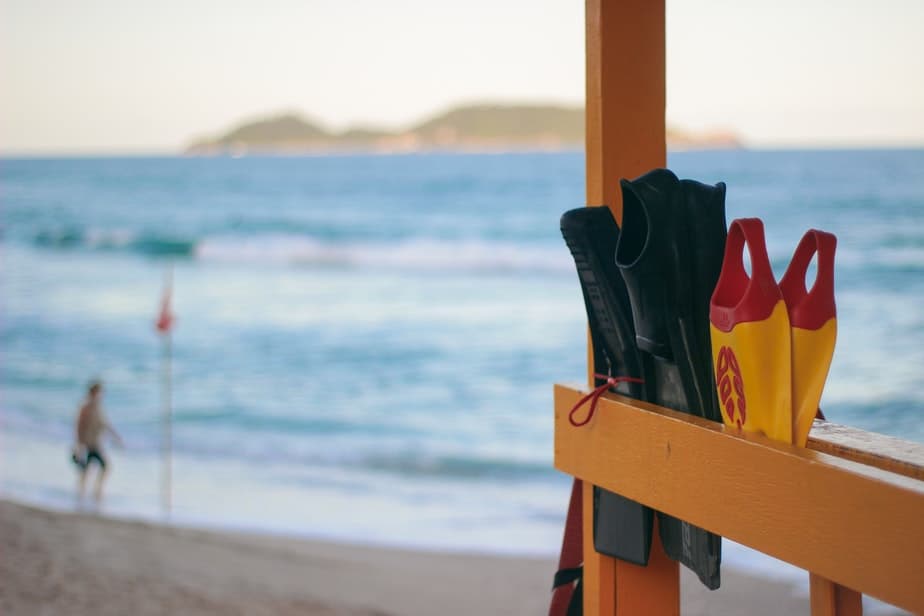
Full Foot vs. Open Heel
This distinction addresses how the fin is worn on your foot. Both types have their advantages, and your choice may depend on the snorkeling conditions and personal preference.
Full Foot Fins:
- Characteristics:
- These fins enclose the entire foot like a shoe.
- Typically designed for warm water use.
- Sizing Nuances:
- Given their shoe-like nature, the sizing is more precise, often aligning with regular shoe sizes.
- It’s vital to get a snug fit, as water cannot be drained, and a loose fit can lead to blisters.
- There’s no allowance for booties or socks, so ensure the size you choose is comfortable on bare feet.
Open Heel Fins:
- Characteristics:
- These fins have an open back, secured with an adjustable strap.
- Often worn with booties, they’re suitable for colder waters.
- Sizing Nuances:
- Because of the adjustable strap, sizing offers a bit more flexibility and can accommodate a range of foot sizes.
- If you’re wearing booties, consider their thickness. Some divers even buy their fins a size larger to ensure a fit with thicker booties.
- The heel strap should be snug but not overly tight to prevent pressure points on the Achilles tendon.
Short vs. Long Blade Fins
The length of the fin blade can greatly influence its performance, as well as how it fits and feels on your foot.
- Characteristics:
- Compact in design and easy to maneuver.
- Ideal for shallow waters, snorkeling in confined spaces, or for travelers looking for a more portable option.
- Sizing Nuances:
- Short blade fins often provide more frequent but less forceful kicks, so the foot pocket’s fit becomes crucial to avoid slippage or chafing.
- They may fit a bit differently than long blade fins of the same size due to their design, so always try them on to ensure comfort.
Long Blade Fins:
- Characteristics:
- These offer more propulsion with each kick, suitable for deep water or covering long distances.
- Often favored by free divers or those looking to dive deeper with less effort.
- Sizing Nuances:
- With a more powerful kick, it’s vital to have a precise fit to ensure efficient power transfer and reduce the risk of losing a fin.
- The added weight and size of the fin might mean that the foot pocket feels different. Ensure there’s no pinching, especially on the top of the foot, which can be more pronounced with a longer blade.
Additional Considerations
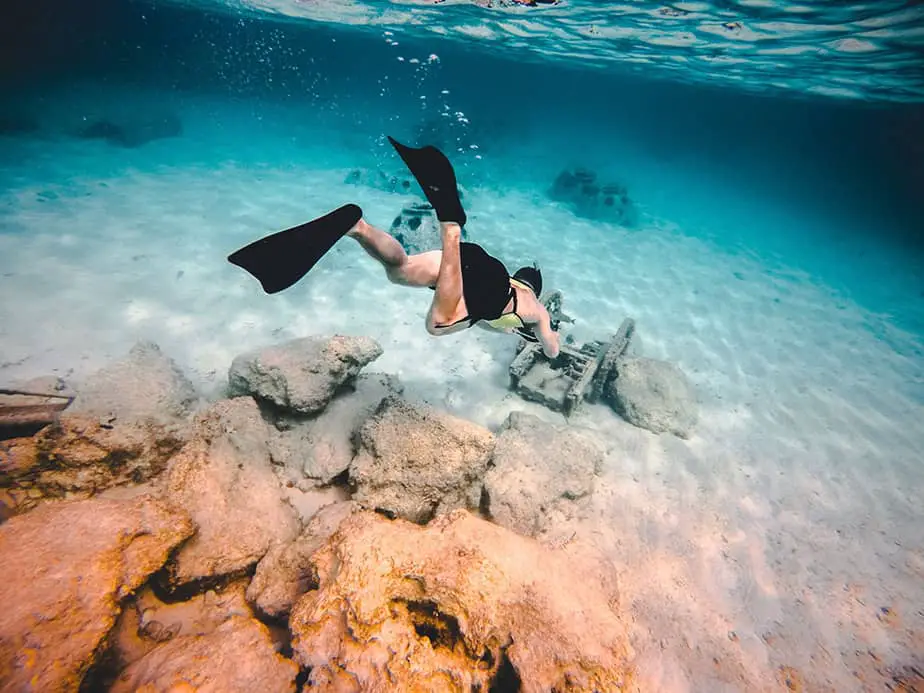
The right fit for your snorkel fins is not only about the foot size but also the conditions in which you’ll be using them. Factors like water conditions and snorkeling depth can dramatically impact the size and type of fin you should go for. Here’s a deep dive into these considerations to ensure you have the perfect fit for your adventures.
Socks and Booties
When snorkeling, sometimes it’s not just about the fins. The type of footwear you pair with your fins can be a game-changer in terms of comfort and protection.
Though they can complicate the fin sizing process, socks and booties provide the following benefits:
- Protection: They shield your feet from blisters that might be caused by repeated rubbing against the fin.
- Thermal Insulation: For colder waters, neoprene booties provide insulation, keeping your feet warm during prolonged snorkeling sessions.
- Safety: They can protect your feet from sharp objects or critters when walking on the beach or shallow waters.
Socks and Booties and Their Impact on Fin Size:
- If you plan to wear snorkeling socks or booties, especially the thicker ones, it’s crucial to account for that added volume when choosing your fin size.
- Generally, for open-heel fins worn with thick booties, you might need to go a size up from your regular shoe size. For full-foot fins, choose designs that can comfortably accommodate the socks without feeling too tight.
Swelling and Temperature Factors
Water temperature can influence the size and shape of our feet, a factor often overlooked when choosing fins.
Warm Water Swelling:
- Immersion in warm water over time can lead to slight swelling of the feet. This is a natural reaction of the body when exposed to prolonged warmth.
- When selecting fins for warm water snorkeling, ensure there’s a bit of wiggle room. A snug fit on land might become too tight underwater after some time, leading to discomfort or even circulation problems.
Cold Water Contraction:
- Cold water can have the opposite effect, causing the feet to contract slightly.
- When snorkeling in cold waters, especially if not wearing insulated booties, this contraction can mean your fins feel a bit looser than expected.
- To account for this, ensure your fins have adjustable straps if they’re open-heeled. For full-foot fins, the fit should be snug but not tight on land, ensuring they remain in place in colder waters.
Water Conditions
The waters you plan to snorkel in can have varying characteristics, which may influence the kind of fins you need. Let’s explore how different water conditions can impact your fin choice:
Calm Waters:
- When swimming in calm waters, like lagoons or sheltered bays, the primary focus is on maneuverability rather than power.
- A smaller, more agile fin might be best suited for such conditions. It allows for quick direction changes and easier navigation among reefs and other underwater attractions without overwhelming power.
Rough or Current-Filled Waters:
- Navigating rough waters or areas with strong currents requires more power and stability. Such conditions often arise in open sea areas or near channels.
- A larger fin, especially those with longer blades, is more apt for these situations. They offer enhanced propulsion, allowing you to swim against currents or handle choppy waters more effectively.
- Also, consider fins with side rails for additional stability, ensuring your kicks translate efficiently into forward motion even in turbulent waters.
Snorkeling Depth
Depth plays a significant role in the snorkeling experience. The deeper you go, the more the water resistance and the greater the need for effective propulsion. Here’s how depth can dictate your fin choice:
Shallow Waters:
- When snorkeling close to the surface or in waters less than 15 feet deep, such as in reefs or coastal areas, the primary concern is avoiding damage to marine life and maneuvering around obstacles.
- Smaller fins, particularly short-blade fins, are ideal for these conditions. They allow for precise movements, ensuring you don’t accidentally brush against delicate coral or marine life.
Deeper Waters:
- Venturing deeper, especially beyond 20 feet, means facing increased water resistance and the need for more powerful and sustained propulsion.
- Larger fins with longer blades are the go-to choice for deeper snorkeling. They provide the necessary power to dive deeper and ascend with ease. They also ensure you can stay at a particular depth without exerting excessive energy.
- If you’re a free diver exploring greater depths, fins specifically designed for free diving are worth considering. These are tailored for deep dives, offering maximum propulsion with minimal effort.
Common Mistakes to Avoid
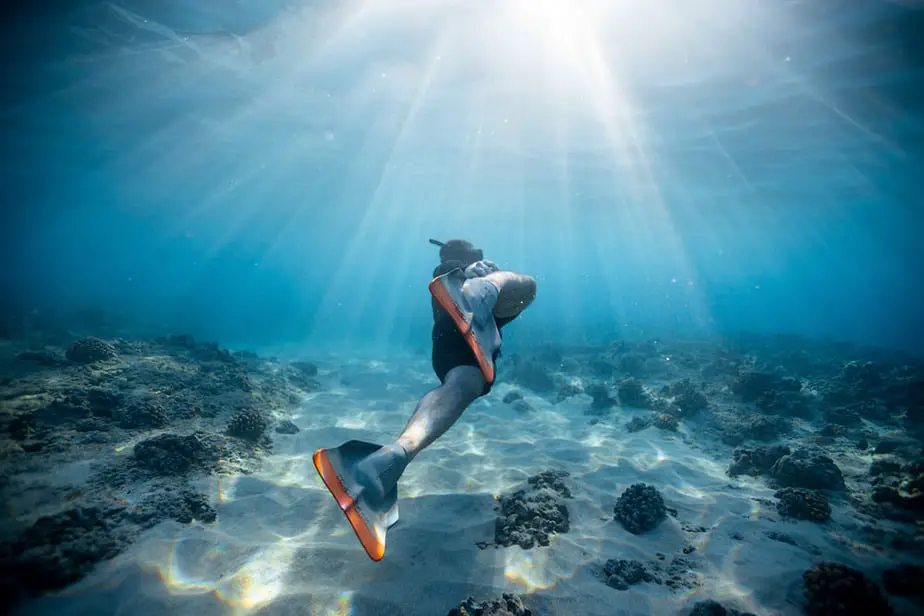
As if selecting the right fin size wasn’t complicated enough, there are common pitfalls that both novices and experienced snorkelers can fall into. Being aware of these mistakes can save you from discomfort, wasted money, or even potential safety risks. Here’s a guide on what not to do:
Overlooking the Purpose
- Generalizing All Fins: Not all fins are created equal. Using deep diving fins for casual snorkeling near the beach or vice versa can make the experience unnecessarily exhausting or ineffective.
- Ignoring Activity Level: If you’re planning on snorkeling actively and covering large areas, you’ll need fins that provide good propulsion without causing fatigue. For more relaxed or stationary observing, maneuverability might be a higher priority.
Ignoring Material Differences
- Stiffness Variations: Fins come in varying degrees of stiffness. While stiffer fins offer more propulsion, they might also demand more leg strength. Too soft, and you might not get the power you need. Know the material and its flex before buying.
- Durability Concerns: Some cheaper fins might be made of materials that degrade quickly, especially in saltwater. It might be cost-effective in the short term but can lead to frequent replacements.
Not Factoring in Transportation
- Bulk and Weight: If you’re traveling to your snorkeling destination, consider the size and weight of your fins. Some are foldable or more lightweight, making them more travel-friendly.
- Overstuffing Dive Bags: Jamming fins into an already stuffed bag can warp their shape or cause damage. Always ensure they fit comfortably in your dive bag or carry them separately.
Sources:

